Voting for Perijove 06 started yesterday, and it will last for another almost 7 days.
This time, I'm not quite free of bias, since I'm interested in an extension of the polar time-lapse sequence, especially in a coverage of the north and south polar FFRs and the presumed edge of the respective polar haze disks. I think - well, I'm rather certain - that it's possible to infer short-time dynamics of the FFRs, and of the vortices near the edge of the haze disk. Due to the expected good contact to Earth during the PJ-6 pass we have a good chance to obtain overlapping images of these regions.
More in the discussion section on the missionjuno site. Of course, there are other interesting targets, too; see Glenn's and John Rogers' (Philosophia-47) comments.
A full latitude coverage would allow for a pole-to-pole animation.
Full Version: Juno perijove 6
Part of the PJ6 dataset has been posted to missionjuno. There were some GDS/DSN issues that are holding up the rest of it, which should be posted on Monday.
Here PJ06 images #109, #110, and #111, in a preliminary version:
Click to view attachment Click to view attachment Click to view attachment
It's the kind of images, I've hoped for, and it's beyond my expecatations. I hope we'll get similar images of the southern FFRs.
Click to view attachment Click to view attachment Click to view attachment
It's the kind of images, I've hoped for, and it's beyond my expecatations. I hope we'll get similar images of the southern FFRs.
Another 5 PJ06 images split into 2 posts for upload limitations:
Click to view attachment Click to view attachment Click to view attachment
Very fascinating!
Click to view attachment Click to view attachment Click to view attachment
Very fascinating!
Click to view attachment Click to view attachment
The target names in the order of the images:
JNCE_2017139_06C00109_V01: POI: Scott' polar cap
JNCE_2017139_06C00110_V01: POI: Southern Edge of Northern FFRs
JNCE_2017139_06C00111_V01: POI: Maximus Spatium
JNCE_2017139_06C00112_V01: POI: Great Polar Spot
[pending (my fault) : JNCE_2017139_06C00113_V01: POI: The Big Red Stripe]
JNCE_2017139_06C00114_V01: POI's: SPOT OF BRAHMAN, Gas irregulartiy
JNCE_2017139_06C00115_V01: POI's: Little Greenish place, HotSpot, Hot Spot Tail
JNCE_2017139_06C00117_V01: POI's: The darkest spot, A multicolored band
JNCE_2017139_06C00118_V01: POI: Belt-Zone border
The target names in the order of the images:
JNCE_2017139_06C00109_V01: POI: Scott' polar cap
JNCE_2017139_06C00110_V01: POI: Southern Edge of Northern FFRs
JNCE_2017139_06C00111_V01: POI: Maximus Spatium
JNCE_2017139_06C00112_V01: POI: Great Polar Spot
[pending (my fault) : JNCE_2017139_06C00113_V01: POI: The Big Red Stripe]
JNCE_2017139_06C00114_V01: POI's: SPOT OF BRAHMAN, Gas irregulartiy
JNCE_2017139_06C00115_V01: POI's: Little Greenish place, HotSpot, Hot Spot Tail
JNCE_2017139_06C00117_V01: POI's: The darkest spot, A multicolored band
JNCE_2017139_06C00118_V01: POI: Belt-Zone border
Looks like there are hundreds of individual storm cell clouds in that last image !!!
Large version (30 pixels per cylindrical camera degree) of the first part of PJ-06 images.
For these images, I fixed two known flaws in my image enhancement subroutine.
I'll upload them to the missionjuno site later today.
For these images, I fixed two known flaws in my image enhancement subroutine.
I'll upload them to the missionjuno site later today.
New wonders to behold on Jupiter. I like this section of Gerald's collection with the array of round circulations:
Click to view attachment
Click to view attachment
That's great, Sean. It almost induces vertigo, which is high praise indeed!
Thanks but all credit to Gerald for the work he has put into producing these images.
My focus was much less on color than it was on the details in the image.
**I've updated the following with more repairs**
Here is a version without the green cast... I tried to be modest but I have a version either side which might suffice also.

...and the same correction applied to the sequence...

&



My focus was much less on color than it was on the details in the image.
**I've updated the following with more repairs**
Here is a version without the green cast... I tried to be modest but I have a version either side which might suffice also.

...and the same correction applied to the sequence...

&



I tried my hand at processing some of Gerald's images. The scaling is a little weird on these, as I squeezed the image horizontally to fit the horizon to a circle, and then resized to 1920x1200 for use as a wallpaper. The original JunoCam images have enough artifacting and noise that I don't think there's much change in the amount of detail. I used the HLVG plugin for Photoshop to remove the greenish cast to the images, and then used the lightest-toned clouds to set the gray point of the image. The results look qualitatively pretty similar to processed Cassini images of Jupiter, so I'm happy.
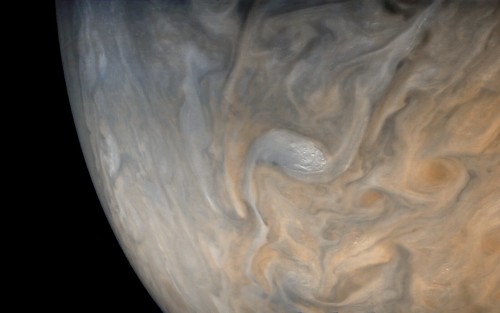
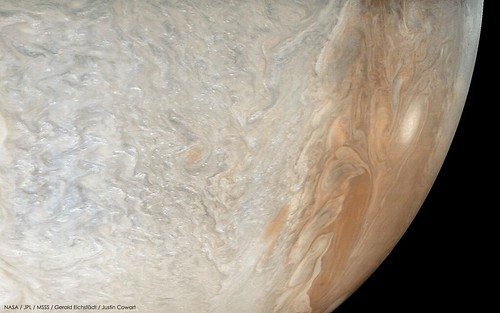


First science result press conference on Thursday (11:00 PST): https://www.missionjuno.swri.edu/news/nasa-...om-juno-mission
Everyone who's processed images from PJ6 (Sean and Justin in particular), if you could upload your images or your favorite subset to missionjuno, Candy Hansen is currently at a Juno science team meeting and would like to highlight your work. Gerald's are obviously there already.
Most of the remaining PJ06 close-up raws are on the mission site by now. So, I had a long night with processing these.
I've modified the red/green ratio from 0.82 to 0.88 for the new processings.
Images #122 and #123 have bad reddish pixels due to some yet unidentified over- or underflow.
I'm not yet sure, how long it will take to fix this software issue. If someone likes to post-process the images, especially the two flawed ones, feel free to do so.
I'll upload the new images to the missionjuno site except #122, #123, and #142. The latter shows greenish portions due to partial CCD saturation.
(I'll notify Candy directly via email, before uploading.)
Before rendering a full movie, I'll first need to find and fix the software issue. In the meanwhile, I can adjust the color weights for the movie according to your wishes. This week, I've only later today, Wednesday and Thursday time for movie renditions. So, I'm not yet sure, whether I'll be able to complete a full pole to pole flyby animation with 125-fold time lapse this week. But I'm confident to able to render some fragments, at least. I'll start rendering the approach sequence for the northern half in about 12 hours, even if the software flaw won't be removed, and hope, that it won't show up in this part of the sequence.
I've modified the red/green ratio from 0.82 to 0.88 for the new processings.
Images #122 and #123 have bad reddish pixels due to some yet unidentified over- or underflow.
I'm not yet sure, how long it will take to fix this software issue. If someone likes to post-process the images, especially the two flawed ones, feel free to do so.
I'll upload the new images to the missionjuno site except #122, #123, and #142. The latter shows greenish portions due to partial CCD saturation.
(I'll notify Candy directly via email, before uploading.)
Before rendering a full movie, I'll first need to find and fix the software issue. In the meanwhile, I can adjust the color weights for the movie according to your wishes. This week, I've only later today, Wednesday and Thursday time for movie renditions. So, I'm not yet sure, whether I'll be able to complete a full pole to pole flyby animation with 125-fold time lapse this week. But I'm confident to able to render some fragments, at least. I'll start rendering the approach sequence for the northern half in about 12 hours, even if the software flaw won't be removed, and hope, that it won't show up in this part of the sequence.
Hi 
Those Junocam pictures processed by you, Gerald, are very inspiring And excellent work everyone !
And excellent work everyone !
Some of my takes on your wonderful work. I have increase the exposure, balanced the colors and sharpened a little. On the full disk Jupiter image, I added some soft light effet to match the feeling we can have by watching at the gas giant with a telescope.
What I love here is that we are seeing actual cumulo-nimbus clouds, the clouds that are forming cells of thunderstorms.
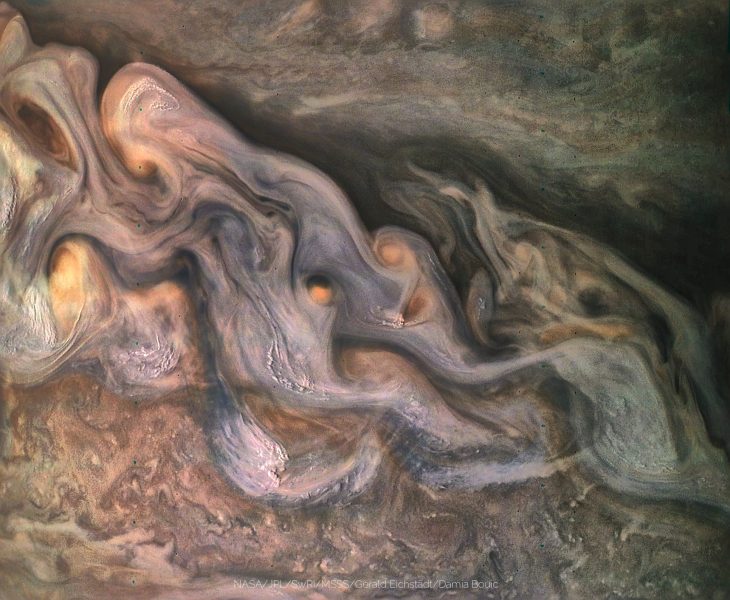
This image was processed to have a view we can have if we had a 50mm lens (I had to reproject the cylindrical image into rectilinear).
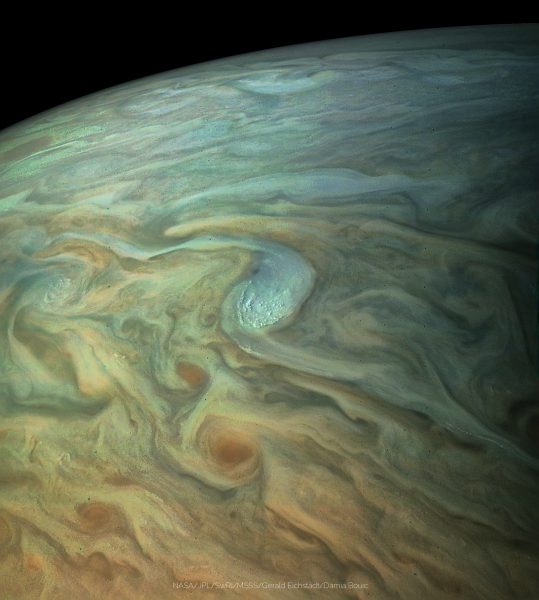
And a full disk Jupiter
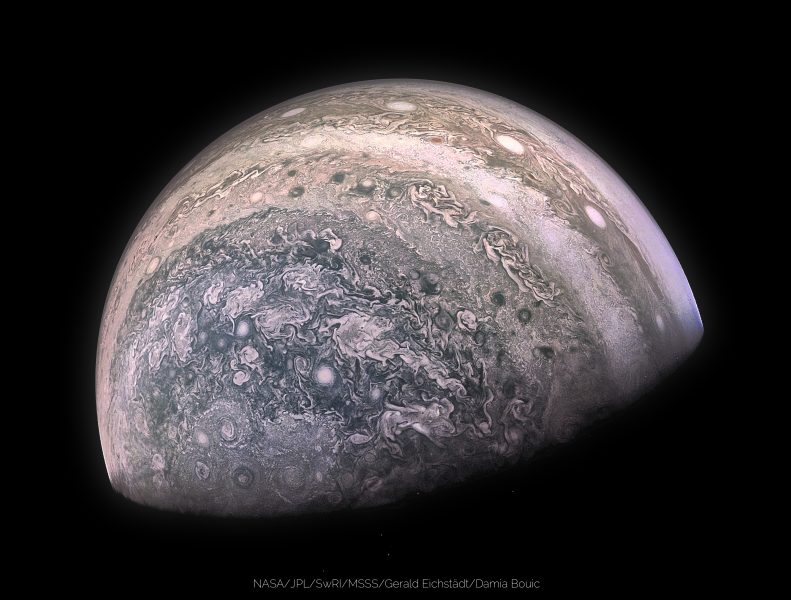
Those Junocam pictures processed by you, Gerald, are very inspiring
Some of my takes on your wonderful work. I have increase the exposure, balanced the colors and sharpened a little. On the full disk Jupiter image, I added some soft light effet to match the feeling we can have by watching at the gas giant with a telescope.
What I love here is that we are seeing actual cumulo-nimbus clouds, the clouds that are forming cells of thunderstorms.

This image was processed to have a view we can have if we had a 50mm lens (I had to reproject the cylindrical image into rectilinear).

And a full disk Jupiter

Everyone who's processed images from PJ6 (Sean and Justin in particular), if you could upload your images or your favorite subset to missionjuno, Candy Hansen is currently at a Juno science team meeting and would like to highlight your work. Gerald's are obviously there already.
I've uploaded my images there now, thanks for the heads up!
These images are absolutely incredible. It's amazing to see at last the fine texture of the cloudscapes. For me, this is the first time Jupiter has ever looked like a place, rather than an abstract painting.
Huge, huge, respect to all whose work has contributed to these images!!

Huge, huge, respect to all whose work has contributed to these images!!
These images are absolutely incredible. It's amazing to see at last the fine texture of the cloudscapes. For me, this is the first time Jupiter has ever looked like a place, rather than an abstract painting.
Huge, huge, respect to all whose work has contributed to these images!!

Huge, huge, respect to all whose work has contributed to these images!!
So now all these people ( including myself ) that were a bit disappointed with the Juno images finally have to take their words back.
Also amazing to see how some higher clouds / layers throw shadows on lower layers.
These are phenomenal.... really feel I am seeing the planet now for first time. Cannot take my eyes off the details.
Thanks to Junocam team and all the incredible image magicians out there.
Craig
Thanks to Junocam team and all the incredible image magicians out there.
Craig
AWESOME!!!
I cant believe Junocam was an 'add-on'. These 3D effects with the deep shadows and high icy 'pileus-like' cloud caps are beyond spectacular.
Congrats to all the image wizards - I cant stop staring.
P
Congrats to all the image wizards - I cant stop staring.
P
What's the size of these 'pileus-like' cottonwool clouds?
Great question. It's fairly easy to figure out from the metadata, but I'm not sure which image this is from or whether any scaling has been done. If you have the altitude from the metadata, then the pixel scale of Junocam at nadir is just 673e-6*altitude in whatever units the altitude is. Of course, farther away from nadir the scale goes down because the range is larger.
I'm amazed at these products. To be honest, we didn't know that half this stuff was in the images ourselves. I hear there was a lengthy discussion about the small clouds at the science team meeting yesterday.
If I could make one suggestion, it would be to include the image identifier somewhere for reference along with every processed image. I prefer the shorthand notation (e.g., pj6-137) instead of the long-winded image ID ("JNCE_2017139_06C00137_V01") that appears in the metadata, but the latter is the official name.
I will be sure to include that info for the next batch.
I was hoping to be able to edit the image details when posting to MissionJuno but that functionality doesn't seem to exist...or am I missing something?
I was hoping to be able to edit the image details when posting to MissionJuno but that functionality doesn't seem to exist...or am I missing something?
If I could make one suggestion, it would be to include the image identifier somewhere for reference along with every processed image. I prefer the shorthand notation (e.g., pj6-137) instead of the long-winded image ID ("JNCE_2017139_06C00137_V01") that appears in the metadata, but the latter is the official name.
For the images on the junocam.picture site, I'm extracting the image number out of the file name, and use it as small caption above each thumbnail. I do also try to use the original file name as a substring of the file name of the processed image. The raw file names, and (usually) the MSSS products, too, contain the product id as a substring in the file name. You also find the product identifier in the metadata (json) files provided in the JunoCam uploads on the missionjuno site.
And, btw., thanks to all of you who help to process these fantastic PJ06 images, or help to encourage those who do the processing!
And, btw., thanks to all of you who help to process these fantastic PJ06 images, or help to encourage those who do the processing!
I was hoping to be able to edit the image details when posting to MissionJuno but that functionality doesn't seem to exist...or am I missing something?
There's a way of indicating the source image when you submit, but I've never submitted anything so I don't know how it works.
You could always put a label on the image if there's a good place to do so, but it does interfere with the aesthetics.
What's the size of these 'pileus-like' cottonwool clouds?
The image above is from PJ6-0113 from an altitude of 5110 km. The clouds are typically about 5-6 pixels in diameter in raw images, which at nadir would be 5.5*673e-6*5110 = 19 km. This is off-nadir somewhat and I'm too lazy to do the geometric processing, but that's a rough order of magnitude -- 20-40 km.
Since working with this data I have refined my processes a little and managed to eke a little more detail.
First frame is the raw image from Gerald. Second image is what I uploaded yesterday. Third image is current work in progress so it hasn't been 'repaired' of any registration marks or hot pixels.
Click to view attachment
Gif compression doesn't do it any favours of course but there is a marked improvement.
**updated**
That gif was terrible... here is a pic

Thanks again for all your efforts Gerald. I hope you are enjoying all the derived images.
First frame is the raw image from Gerald. Second image is what I uploaded yesterday. Third image is current work in progress so it hasn't been 'repaired' of any registration marks or hot pixels.
Click to view attachment
Gif compression doesn't do it any favours of course but there is a marked improvement.
**updated**
That gif was terrible... here is a pic

Thanks again for all your efforts Gerald. I hope you are enjoying all the derived images.
There's a way of indicating the source image when you submit, but I've never submitted anything so I don't know how it works.
You could always put a label on the image if there's a good place to do so, but it does interfere with the aesthetics.
You could always put a label on the image if there's a good place to do so, but it does interfere with the aesthetics.
There is a specific edit field in the lower left of the submission dialog.
When creating labels on the image, it's difficult for release in the NASA Photojournal or as an image of the week. You'll be contacted and asked to provide a version without annotations or labels in case your image is selected for these purposes.
@Seán: I'm enjoying the derived products very much, and am happy to learn about options for improvements. Currently, I'm rendering a 125-fold 25fps PJ06 flyby movie of scheduled 1min36sec, however a version with cuts when switching to the animation of the next raw image. I hope, Mike can forgive me one more time.
I'm intending to create one or more revised versions in a few weeks.
I'll likely be offline between Friday and Sunday, so I hope, that the movie will be completed and uploaded tomorrow in the evening (CEST) resp. in the morning (PDT).
I would love to have a go at processing the P06 animation when it is finished. ( with uploaded frame sequence like P05? )
I am still working with P05 animation and applying what I have learned making P06 & P04 images to that sequence.
Here is an example of P05 stills I have upscaled to 1080x1920...


The idea is to get the P05 animation to this standard.
It is very promising but a lot of work to smooth or disguise the sudden exposure shifts, some overlapping frames would be useful of course but I do appreciate how time consuming it must be to render these frames.
I am still working with P05 animation and applying what I have learned making P06 & P04 images to that sequence.
Here is an example of P05 stills I have upscaled to 1080x1920...


The idea is to get the P05 animation to this standard.
It is very promising but a lot of work to smooth or disguise the sudden exposure shifts, some overlapping frames would be useful of course but I do appreciate how time consuming it must be to render these frames.
Processed image #117, centered over the southern edge of the South Equatorial Belt. The belt is kind of messy from block artifacting, but the jet marking the southern boundary of the belt and adjacent South Tropical Zone are much more clear.
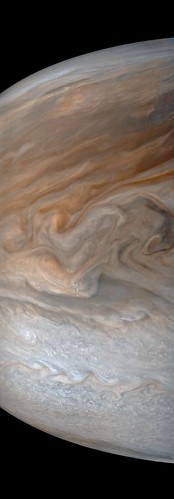
Some features of interest. Here's another example of probable convection and associated clouds located along the turbulent boundary between the South Equatorial Belt and South Tropical Zone:

We've seen from Sean's excellent processing image #118 centered on the South Tropical Zone that there's a lot of these convective-type features. Seeing many of the same clouds in this more oblique image. There's hints of cloud shadows as well, and given that those shadows look detached from the convective cells, these may be actually occurring well above the surrounding zone clouds:

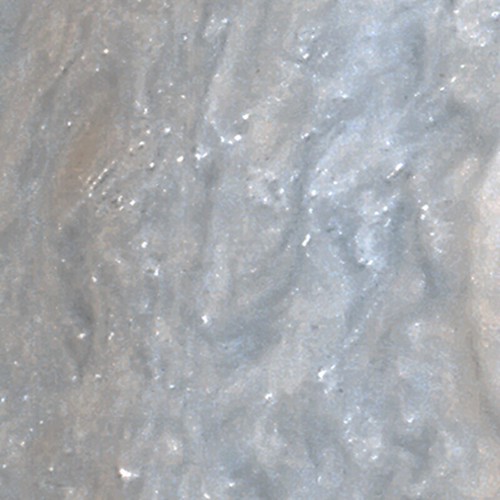

Some features of interest. Here's another example of probable convection and associated clouds located along the turbulent boundary between the South Equatorial Belt and South Tropical Zone:

We've seen from Sean's excellent processing image #118 centered on the South Tropical Zone that there's a lot of these convective-type features. Seeing many of the same clouds in this more oblique image. There's hints of cloud shadows as well, and given that those shadows look detached from the convective cells, these may be actually occurring well above the surrounding zone clouds:


I never thought I'd say this about any of the JunoCam images but: The PJ-6 images are the most spectacular images of Jupiter I've ever seen. I was aware that the JunoCam images would be better than lots of people expected (and the Earth flyby images hinted at this) but this is far beyond my wildest expectations.
There are interesting details just about everywhere that are not present in earlier images of Jupiter or they are visible - but not with the same clarity as in the Juno images. This is especially true of the small whitish clouds (and they seem to be much more frequent than earlier images suggested). The same can be said about cloud shadows and vertical structure - I think Juno has been able to directly image the elevation difference between bigger clouds, e.g. dark and light clouds.
Here are my versions of PJ-6 image 112 (observation name: "POI: Great Polar Spot"). They are not based on Gerald's images, however his images were very useful as a 'sanity check'. I'm especially impressed by how fast he's able to churn out high quality image products - it takes me far more time.
And here are the images, first a version where global illumination has been removed, the contrast has been exaggerated and small scale features have been sharpened with an unsharp mask:
Click to view attachmentClick to view attachmentClick to view attachment
And an approximately true color/contrast version:
Click to view attachmentClick to view attachment
Click to view attachment
There are interesting details just about everywhere that are not present in earlier images of Jupiter or they are visible - but not with the same clarity as in the Juno images. This is especially true of the small whitish clouds (and they seem to be much more frequent than earlier images suggested). The same can be said about cloud shadows and vertical structure - I think Juno has been able to directly image the elevation difference between bigger clouds, e.g. dark and light clouds.
Here are my versions of PJ-6 image 112 (observation name: "POI: Great Polar Spot"). They are not based on Gerald's images, however his images were very useful as a 'sanity check'. I'm especially impressed by how fast he's able to churn out high quality image products - it takes me far more time.
And here are the images, first a version where global illumination has been removed, the contrast has been exaggerated and small scale features have been sharpened with an unsharp mask:
Click to view attachmentClick to view attachmentClick to view attachment
And an approximately true color/contrast version:
Click to view attachmentClick to view attachment
Click to view attachment
Astounding work, Bjorn (and everyone else!). Straight out of a Clarke novel... and now I've got Holst on the headphones.
And to think this camera nearly didn't make it on board (and every planned mission after Juno focuses heavily on the moons). It's the GRB's turn next perijove, right?
And to think this camera nearly didn't make it on board (and every planned mission after Juno focuses heavily on the moons). It's the GRB's turn next perijove, right?
Can only echo thanks to the Juno team and to everyone else working on and supplying this astounding imagery.
My jaw has literally been hanging open this whole thread.
My jaw has literally been hanging open this whole thread.
As I mentioned previously, these latest JunoCam images are awesome. I took a fairly detailed look at one of the images I posted earlier with particular attention to cloud elevation differences. First an unusual image. This is a perfectly flat DEM with several spikes - their shadows show the direction of sunlight in one of the JunoCam images I posted earlier:
Click to view attachment
And here is the corresponding JunoCam image. This is one of the images I posted earlier but here I have added some annotations:
Click to view attachment
A. Bright, high altitude clouds that usually seem to be isolated or to occur in small clusters.
B. These clouds are similar to (A) in color and altitude. But unlike (A) they appear elongated, probably parallel to the wind direction. At least in some cases they indicate high wind speeds - clouds like these are visible at lower resolution in Voyager images showing the northeast periphery of the Great Red Spot where the wind speed is very high.
C. I suspect that here we are seeing the darker and lower cloud deck through tenuous and mostly transparent high altitude clouds. This is more obvious when looking at the red channel only.
D and E. Here JunoCam may have directly observed/imaged the elevation difference between the dark clouds and the less dark clouds south of the 'color/brightness transition'. Areas indicated by (D) appear slightly darker than areas indicated by (E). When taking into account the direction of the shadows in the DEM/spike shadow render above, the areas indicated by (D) may be in shadow caused by the brighter clouds south of the brightness/color transitions while the areas indicated by (E) are not in shadow.
F. These clouds seem somewhat similar to (A) but they occur in far bigger clusters. Apparently they also might be at a slightly lower altitude - this is not obvious though.
G. Possible shadows hinting at elevation differences but color/brightness variations are also a possibility. Features like this are very common.
Click to view attachment
And here is the corresponding JunoCam image. This is one of the images I posted earlier but here I have added some annotations:
Click to view attachment
A. Bright, high altitude clouds that usually seem to be isolated or to occur in small clusters.
B. These clouds are similar to (A) in color and altitude. But unlike (A) they appear elongated, probably parallel to the wind direction. At least in some cases they indicate high wind speeds - clouds like these are visible at lower resolution in Voyager images showing the northeast periphery of the Great Red Spot where the wind speed is very high.
C. I suspect that here we are seeing the darker and lower cloud deck through tenuous and mostly transparent high altitude clouds. This is more obvious when looking at the red channel only.
D and E. Here JunoCam may have directly observed/imaged the elevation difference between the dark clouds and the less dark clouds south of the 'color/brightness transition'. Areas indicated by (D) appear slightly darker than areas indicated by (E). When taking into account the direction of the shadows in the DEM/spike shadow render above, the areas indicated by (D) may be in shadow caused by the brighter clouds south of the brightness/color transitions while the areas indicated by (E) are not in shadow.
F. These clouds seem somewhat similar to (A) but they occur in far bigger clusters. Apparently they also might be at a slightly lower altitude - this is not obvious though.
G. Possible shadows hinting at elevation differences but color/brightness variations are also a possibility. Features like this are very common.
Superb image processing and analysis. Great to see both enhanced and unenhanced/realistic versions to get the complete picture. Some first reactions - if I have the larger scale context right:
The dark areas next to D/E look like the IR hot spots at the edge of a belt.
The shadow in D agrees with my subjective impression of the brighter laminar appearing clouds being higher and overlaying the darker adjacent clouds.
G looks like cloud brightness variations to me. These narrow strands look similar even in differing orientations?
"A" features clearly have high cloud tops. I wonder if their bases are low enough to tap into the water vapor layers, helping to give enough opacity to yield the brighter white color. The more true color images suggest these tops may still be below some of the high altitude haze. This haze is yet thin enough to have distinct shadows visible. It seems there's a narrow range of haze optical thickness that allows this type of visibility.
The dark areas next to D/E look like the IR hot spots at the edge of a belt.
The shadow in D agrees with my subjective impression of the brighter laminar appearing clouds being higher and overlaying the darker adjacent clouds.
G looks like cloud brightness variations to me. These narrow strands look similar even in differing orientations?
"A" features clearly have high cloud tops. I wonder if their bases are low enough to tap into the water vapor layers, helping to give enough opacity to yield the brighter white color. The more true color images suggest these tops may still be below some of the high altitude haze. This haze is yet thin enough to have distinct shadows visible. It seems there's a narrow range of haze optical thickness that allows this type of visibility.
For completeness, a few hours ago I've uploaded revised #122, and #123, after fixing the overflow for saturated pixels.
The first version of the PJ06 flyby animation is completed, too. It's now mostly a matter of upload bandwidth. I'll try an upload to youtube, as well as a first subset of zipped stills to the junocam.pictures webspace, and intend to provide links in about two or three hours. The zipped stills will be 2.34 GB, more than I can upload before next week.
The first version of the PJ06 flyby animation is completed, too. It's now mostly a matter of upload bandwidth. I'll try an upload to youtube, as well as a first subset of zipped stills to the junocam.pictures webspace, and intend to provide links in about two or three hours. The zipped stills will be 2.34 GB, more than I can upload before next week.
This is a "lo-fi" version of our main content. To view the full version with more information, formatting and images, please click here.
























